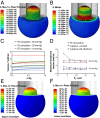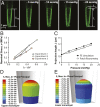Biophysical implications of lipid bilayer rheometry for mechanosensitive channels
- PMID: 25201991
- PMCID: PMC4183281
- DOI: 10.1073/pnas.1409011111
Biophysical implications of lipid bilayer rheometry for mechanosensitive channels
Abstract
The lipid bilayer plays a crucial role in gating of mechanosensitive (MS) channels. Hence it is imperative to elucidate the rheological properties of lipid membranes. Herein we introduce a framework to characterize the mechanical properties of lipid bilayers by combining micropipette aspiration (MA) with theoretical modeling. Our results reveal that excised liposome patch fluorometry is superior to traditional cell-attached MA for measuring the intrinsic mechanical properties of lipid bilayers. The computational results also indicate that unlike the uniform bilayer tension estimated by Laplace's law, bilayer tension is not uniform across the membrane patch area. Instead, the highest tension is seen at the apex of the patch and the lowest tension is encountered near the pipette wall. More importantly, there is only a negligible difference between the stress profiles of the outer and inner monolayers in the cell-attached configuration, whereas a substantial difference (∼30%) is observed in the excised configuration. Our results have far-reaching consequences for the biophysical studies of MS channels and ion channels in general, using the patch-clamp technique, and begin to unravel the difference in activity seen between MS channels in different experimental paradigms.
Keywords: MscL; azolectin; electrophysiology; finite element modeling.
Conflict of interest statement
The authors declare no conflict of interest.
Figures




Similar articles
-
The role of MscL amphipathic N terminus indicates a blueprint for bilayer-mediated gating of mechanosensitive channels.Nat Commun. 2016 Jun 22;7:11984. doi: 10.1038/ncomms11984. Nat Commun. 2016. PMID: 27329693 Free PMC article.
-
"Force-from-lipids" gating of mechanosensitive channels modulated by PUFAs.J Mech Behav Biomed Mater. 2018 Mar;79:158-167. doi: 10.1016/j.jmbbm.2017.12.026. Epub 2017 Dec 28. J Mech Behav Biomed Mater. 2018. PMID: 29304430
-
Voltage-induced gating of the mechanosensitive MscL ion channel reconstituted in a tethered lipid bilayer membrane.Biosens Bioelectron. 2008 Jan 18;23(6):919-23. doi: 10.1016/j.bios.2007.09.014. Epub 2007 Oct 3. Biosens Bioelectron. 2008. PMID: 17996439
-
Mechanical properties of lipid bilayers and regulation of mechanosensitive function: from biological to biomimetic channels.Channels (Austin). 2012 Jul-Aug;6(4):220-33. doi: 10.4161/chan.21085. Epub 2012 Jul 1. Channels (Austin). 2012. PMID: 22790280 Free PMC article. Review.
-
Lipid-protein interactions: Lessons learned from stress.Biochim Biophys Acta. 2015 Sep;1848(9):1744-56. doi: 10.1016/j.bbamem.2015.04.012. Epub 2015 Apr 25. Biochim Biophys Acta. 2015. PMID: 25922225 Review.
Cited by
-
Nanomechanical properties of MscL α helices: A steered molecular dynamics study.Channels (Austin). 2017 May 4;11(3):209-223. doi: 10.1080/19336950.2016.1249077. Epub 2016 Oct 18. Channels (Austin). 2017. PMID: 27753526 Free PMC article.
-
"Force-From-Lipids" Dependence of the MscCG Mechanosensitive Channel Gating on Anionic Membranes.Microorganisms. 2023 Jan 12;11(1):194. doi: 10.3390/microorganisms11010194. Microorganisms. 2023. PMID: 36677485 Free PMC article.
-
A new window into the molecular physiology of membrane proteins.J Physiol. 2015 Jan 15;593(2):355-62. doi: 10.1113/jphysiol.2014.283150. Epub 2014 Dec 1. J Physiol. 2015. PMID: 25630257 Free PMC article. Review.
-
Quantitative description of ion transport via plasma membrane of yeast and small cells.Front Plant Sci. 2015 Jun 11;6:425. doi: 10.3389/fpls.2015.00425. eCollection 2015. Front Plant Sci. 2015. PMID: 26113853 Free PMC article. Review.
-
Piezo1 mechanosensitive channels: what are they and why are they important.Biophys Rev. 2019 Oct;11(5):795-805. doi: 10.1007/s12551-019-00584-5. Epub 2019 Sep 7. Biophys Rev. 2019. PMID: 31494839 Free PMC article. Review.
References
-
- Häse CC, Le Dain AC, Martinac B. Purification and functional reconstitution of the recombinant large mechanosensitive ion channel (MscL) of Escherichia coli. J Biol Chem. 1995;270(31):18329–18334. - PubMed
-
- Martinac B. Bacterial mechanosensitive channels as a paradigm for mechanosensory transduction. Cell Physiol Biochem. 2011;28(6):1051–1060. - PubMed
-
- Cox CD, et al. Selectivity mechanism of the mechanosensitive channel MscS revealed by probing channel subconducting states. Nat Commun. 2013;4:2137. - PubMed
-
- Maroto R, et al. TRPC1 forms the stretch-activated cation channel in vertebrate cells. Nat Cell Biol. 2005;7(2):179–185. - PubMed
Publication types
MeSH terms
Substances
LinkOut - more resources
Full Text Sources
Other Literature Sources
Miscellaneous

